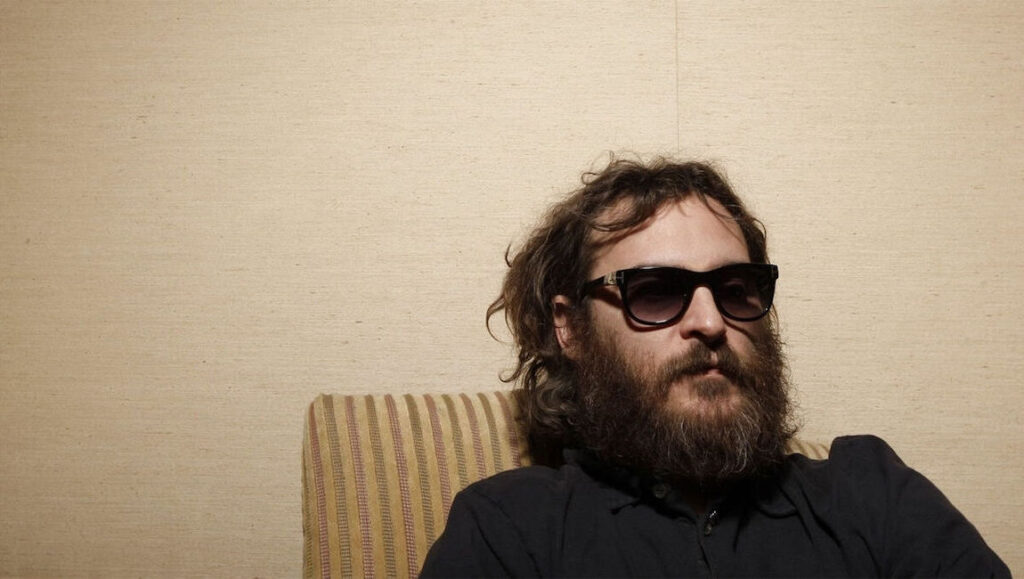The opening montage of I’m Still Here summons a cloud of fame engulfing actor Joaquin Phoenix — awards, accolades, the media appearances, the movies, and nominations. Then, cutting to near darkness, the film switches into handheld reality TV mode with promises of behind-the-scenes impromptu discussions and interactions. Phoenix ineloquently explains that the glow of his celebrity halo has become his personal albatross, and it’s a burden he no longer wants to bear. Addressing the camera, addressing us, and addressing himself, he says that he wants to do something for himself; he wants to stop the sham, and he wants to stop playing the role of Joaquin Phoenix. Five minutes in, this bluster has a plausible ring to it. It’s the familiar but unsympathetic plight of the celebrity, and Phoenix’s solution is to quit acting and follow his dream of excelling in hip-hop music. But over the course of the documentary, Phoenix never stops acting and he certainly never stops acquiescing to his cause célèbre; rather, he simply manipulates it through grand design, sending it in a different direction. It’s within this dubious transformation that I’m Still Here finds its entertaining brilliance. Phoenix and crew are caught in a whirlwind of self-absorbed buffoonery that mocks itself as easily as it mocks the audience.
Like any celebrity meltdown, watching Phoenix’s devolution is both frustrating and entertaining. He slowly becomes more disheveled and delusional as he pursues Sean “Diddy” Combs to produce his awful hip-hop material. He abuses his staff and carries on as if the sun revolves around him. Meanwhile, the film records the touchstone public appearances Phoenix made on behalf of Two Lovers, most notably on the David Letterman Show and its well-publicized aftermath. The spiral inevitably starts heading downwards, hitting rock bottom with a ridiculous performance at a Miami club that is appropriately cut short when Phoenix picks a fight with a member of the audience and pathetically retires to the bathroom to have a good barf. Much of the early discussion about I’m Still Here focused on whether the documentary was “real” — as if that word, given the context, has any meaning. There’s plenty of proof in the film that it’s neither real nor fake, and the air of mystery regarding the intentions of Phoenix and director Casey Affleck simply adds an element of much-appreciated ambiguity. The meta addendum, of course, is that Affleck spilled the beans and tossed out the enigma in favor of receiving praise for creating it.
There was never any question whether Phoenix was to some extent acting, but his character was not defined by the simple commands of “action” and “cut,” and it extended far beyond the frame of the lens. Like any great performance (or performance art), the success of Phoenix’s role and ironized rebirth in I’m Still Here lies in his own resolve which, in this case, was an amazing two-year commitment. Ultimately, Affleck and Phoenix’s gonzo experiment falls somewhere between the audaciousness of Andy Kaufman and the inanity of Britney Spears. One also can’t help but think about Martin Sheen’s onscreen breakdown in Apocalypse Now,” which Francis Ford Coppola had no problem using for dramatic effect. I’m Still Here is a hybrid of all these factors in the age of reality TV. It acknowledges the insipid nature of celebrity culture while using those very same avenues to manipulate the consumers sitting in the audience. It’s a clever flash-in-the-pan that will probably never register beyond this moment and its non-controversy controversy. As the film itself points out, when it comes to the private lives of public people, we have a very short-term memory, and “The Lost Years of Joaquin Phoenix’”will be no different. But for now, it’s a hilarious and poignant artifact of its time — and ready for its close-up, Mr. DeMille.


Comments are closed.